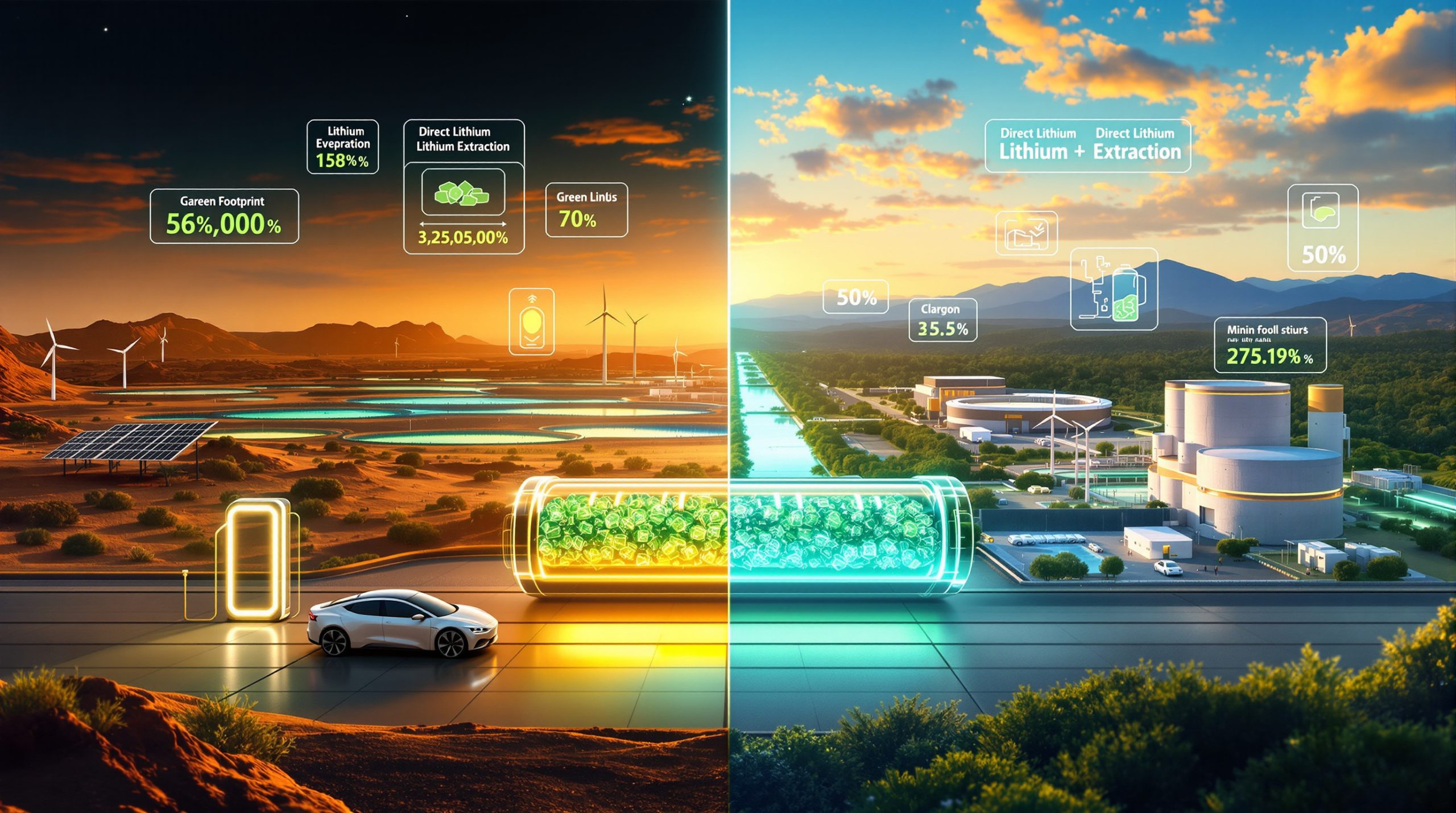E3 Lithium's Clearwater Project: Key Permit Approvals and Development Milestones
E3 Lithium has reached a significant milestone in its lithium development journey, securing crucial regulatory permits for Phase 2 of its Clearwater Project Demonstration Facility in Alberta. These approvals mark a pivotal advancement in establishing North America's lithium supply chain and represent the first permits issued under Alberta's innovative Brine-Hosted Mineral resources regulations.
The Canadian company continues to demonstrate remarkable progress as it transitions from initial testing to a more comprehensive demonstration phase that will validate its proprietary direct lithium extraction (DLE) technology at a larger scale. Furthermore, these developments come at a time when lithium industry innovations are increasingly critical to meeting global energy transition goals.
What regulatory permits has E3 Lithium secured for the Clearwater facility?
E3 Lithium has successfully obtained all necessary regulatory permits from the Alberta Energy Regulator (AER) for Phase 2 of its Clearwater Project Demonstration Facility. This regulatory milestone is particularly significant as these approvals represent the first permits issued under Alberta's new Brine-Hosted Mineral resources regulations.
The company has secured two critical approvals that enable it to proceed with the next development phase:
- Directive 065 approval for a mineral scheme encompassing subsurface injection of produced fluids
- Directive 056 approvals for both mineral wells and a mineral facility, covering essential technical and licensing requirements for operation
E3 Lithium President and CEO Chris Doornbos emphasized the importance of these permits, noting the company's enthusiasm about receiving the approvals, particularly the recently approved Directive 065, which enables them to launch the next phase of technology demonstration.
These regulatory achievements don't merely represent administrative hurdles overcome—they establish a clear precedent and pathway for future lithium development projects in Alberta, potentially accelerating the growth of this emerging industry throughout the province. According to a recent regulatory update, these approvals signify important progress for the entire lithium sector in Alberta.
How will Phase 2 advance E3 Lithium's demonstration facility?
Phase 2 represents a substantial expansion of E3 Lithium's technology validation efforts, building upon the foundation established in Phase 1 with several key developments:
- Strategic well drilling program that includes both production and injection wells
- Comprehensive evaluation of the Leduc Aquifer's reservoir characteristics and flow rates
- Integration with existing infrastructure from Phase 1, including the 30-column direct lithium extraction (DLE) system
- Creation of a complete process system capable of converting brine to battery-grade lithium carbonate
This expansion is designed to provide crucial data for the company's commercial facility design. The wells drilled during Phase 2 will deliver vital information about the Leduc Aquifer's properties, which will directly inform the design of the commercial well scheme, gathering system, and treatment equipment.
The integration of Phase 2 wells with the existing 30-column DLE system from Phase 1 will create a comprehensive end-to-end process system capable of converting raw brine to battery-grade lithium refining. This complete system demonstration represents a critical step in de-risking the technology for commercial deployment.
What is the current status of the Clearwater Project?
The Clearwater Project is advancing through a methodical development sequence with multiple concurrent activities:
- Phase 1 commissioning is currently underway and nearing completion
- Phase 2 drilling program scheduled to commence in early to mid-October 2025
- Commercial facility permitting is progressing with the Directive 056 application being finalized
- Environmental Protection and Enhancement Act (EPEA) application in preparation for submission
The company is taking a strategic approach by overlapping development phases to accelerate the overall project timeline. As Phase 1 commissioning concludes, E3 Lithium is preparing to immediately transition to Phase 2 drilling operations, maintaining project momentum.
Key equipment for the 30-column DLE system arrived at the Clearwater project site in July 2025, enabling the current commissioning activities. This equipment will support both phases of the planned testing program, providing operational continuity between development stages.
What technological innovations are being implemented at the Clearwater facility?
The Clearwater facility showcases several innovative technological elements that position E3 Lithium at the forefront of sustainable lithium production:
Direct Lithium Extraction (DLE) System
- 30-column configuration designed for optimal extraction efficiency
- Proprietary technology that selectively extracts lithium from brine
- Reduced environmental footprint compared to traditional evaporation pond methods
The DLE system represents a significant advancement over conventional lithium extraction techniques, which typically rely on large evaporation ponds that consume substantial water resources and require extensive land areas. E3 Lithium's approach selectively extracts lithium from the brine while allowing the majority of the water to be reinjected into the aquifer.
Integrated Process System
- Seamless connection between extraction and purification stages
- End-to-end capability from raw brine to battery-grade lithium carbonate
- Scalable design principles applicable to future commercial operations
The integration of wells, extraction columns, and purification units creates a complete brine-to-battery-grade lithium carbonate process system. This comprehensive approach allows E3 Lithium to validate the entire production chain at the demonstration scale before scaling up to commercial operations. Additionally, the project incorporates innovative lithium extraction methods that could transform how the industry operates globally.
What commercial implications do these permit approvals have?
The permit approvals secured by E3 Lithium carry significant commercial implications that extend beyond regulatory compliance:
- Regulatory pathway validation for future commercial development
- Risk reduction through demonstration of regulatory compliance
- Accelerated timeline for commercial facility permitting
- Investor confidence boost through achievement of key regulatory milestones
- Strategic positioning within the North American lithium supply chain
By being the first company to secure permits under Alberta's Brine-Hosted Mineral resources regulations, E3 Lithium has effectively validated the regulatory pathway for lithium production in the province. This precedent-setting achievement reduces regulatory uncertainty for both the company and potential investors.
The permits also enhance E3 Lithium's strategic position within the emerging North American lithium supply chain. As automobile manufacturers and battery producers seek secure, domestic sources of battery materials, E3 Lithium's progress toward commercial production strengthens its potential role as a key supplier.
How does the Clearwater Project fit into Alberta's resource development landscape?
The Clearwater Project represents a transformative opportunity for Alberta's resource sector, diversifying beyond traditional energy production:
Diversification Benefits
- Expansion beyond traditional oil and gas into critical minerals
- Leveraging existing expertise in subsurface resource development
- Creating new economic opportunities in the clean energy transition
Alberta has developed world-class expertise in subsurface resource management through decades of oil and gas development. The Clearwater Project demonstrates how this expertise can be applied to lithium extraction, creating new economic opportunities while supporting the clean energy transition.
Regulatory Innovation
- First permits issued under Brine-Hosted Mineral resources regulations
- Establishing precedents for future lithium development projects
- Demonstrating Alberta's adaptability to emerging resource opportunities
Alberta's development of specific regulations for brine-hosted minerals demonstrates the province's commitment to facilitating responsible resource development beyond its traditional focus. These regulatory innovations create a framework that balances development opportunities with environmental protection.
The Clearwater Project serves as a model for how Alberta can diversify its resource economy while maintaining its leadership in resource development expertise and technology. In particular, the project showcases essential mining permitting insights that could benefit other emerging resource projects.
What infrastructure advantages does the Clearwater Project leverage?
The Clearwater Project benefits from several strategic infrastructure advantages that enhance its development potential:
- Brownfield site acquisition at the former Dyck Gravel Pit in Mountain View County
- Existing road access reducing development costs and environmental impact
- Proximity to utilities including power and natural gas infrastructure
- Regional industrial expertise supporting project development and operations
By selecting a brownfield site with existing infrastructure, E3 Lithium has minimized both development costs and environmental impacts. The former gravel pit already had industrial zoning, road access, and proximity to required utilities, allowing for accelerated development timelines.
Alberta's established oil and gas industry provides a rich ecosystem of service providers, equipment suppliers, and technical experts that E3 Lithium can leverage for project development and operations. This regional industrial expertise represents a significant competitive advantage compared to lithium development in regions without established resource industries.
What are the next steps for E3 Lithium's Clearwater Project?
E3 Lithium has outlined several critical next steps for the Clearwater Project as it progresses toward commercial development:
- Complete Phase 1 commissioning of the initial DLE system
- Initiate Phase 2 drilling program in October 2025
- Finalize and submit commercial facility permitting applications
- Connect Phase 2 wells to the existing DLE system
- Validate end-to-end process from brine extraction to lithium carbonate production
The company is taking a methodical approach to project development, with each phase building upon previous achievements while providing critical data for subsequent stages. This progressive validation strategy reduces technical and financial risks while maintaining development momentum.
E3 Lithium is targeting potential commercial facility construction in the second half of 2026, contingent upon successful completion of the demonstration phases and regulatory approvals. This timeline positions the company to potentially become one of the first domestic producers of battery-grade lithium in North America.
How does this project contribute to North American lithium supply security?
The Clearwater Project represents a significant contribution to North American lithium supply security in several key ways:
Domestic Production Capacity
- Reducing import dependence on foreign lithium sources
- Shortening supply chains for North American battery manufacturers
- Enhancing resource security for critical clean energy minerals
North America currently imports the majority of its lithium supply, creating vulnerability in the battery supply chain. The Clearwater Project represents an opportunity to develop a domestic source of this critical mineral, reducing dependence on imports and enhancing supply security.
Strategic Positioning
- First commercial lithium production facility in Western Canada
- Significant production potential for battery-grade lithium compounds
- Integration opportunity with emerging North American battery ecosystem
As automobile manufacturers and battery producers establish operations in North America, the need for locally sourced lithium continues to grow. The Clearwater Project's strategic location in Alberta positions E3 Lithium to become a key supplier within this emerging ecosystem, supporting the development of a more resilient and integrated supply chain.
The project's focus on producing battery-grade lithium carbonate—rather than an intermediate product requiring further processing—further strengthens its contribution to supply chain security by eliminating additional processing steps that might otherwise occur overseas. This aligns with growing recognition of critical minerals demand for energy transition.
What environmental considerations are addressed in the Clearwater Project?
E3 Lithium has incorporated several environmental considerations into the Clearwater Project design and implementation:
Sustainable Extraction Technology
- DLE technology eliminates the need for large evaporation ponds
- Reduced water consumption compared to traditional lithium extraction methods
- Smaller physical footprint minimizing land disturbance
The company's DLE technology represents a significant environmental improvement over traditional lithium extraction methods that rely on evaporation ponds. By selectively extracting lithium from brine and reinjecting the processed water back into the aquifer, E3 Lithium minimizes both water consumption and land disturbance.
Site Selection Strategy
- Brownfield development at previously disturbed industrial locations
- Reduced habitat impact through strategic site selection
- Infrastructure reuse minimizing new construction requirements
By selecting a brownfield site for the demonstration facility, E3 Lithium has minimized additional environmental impacts associated with new development. The former gravel pit location already had industrial activity and infrastructure, reducing the need for new disturbance.
These environmental considerations demonstrate E3 Lithium's commitment to responsible resource development principles and align the project with broader sustainability goals in the clean energy transition.
FAQs About E3 Lithium's Clearwater Project
What is direct lithium extraction (DLE) technology?
Direct lithium extraction is an innovative process that selectively removes lithium from brine solutions using specialized adsorbents or ion exchange materials. This technology eliminates the need for large evaporation ponds and significantly reduces water consumption and land use compared to traditional methods. E3 Lithium's proprietary DLE system uses a 30-column configuration designed for optimal extraction efficiency.
Where is the Leduc Aquifer located?
The Leduc Aquifer is located in Alberta, Canada, and represents one of North America's largest lithium resources contained in brine. The formation extends across a significant portion of central and southern Alberta. The aquifer was initially developed for oil production but has been identified as containing substantial dissolved lithium that can be extracted using DLE technology.
What advantages does brine-based lithium extraction offer?
Brine-based lithium extraction offers several advantages including lower energy requirements compared to hard-rock mining, reduced land disturbance, potential for co-production of other valuable minerals, and the ability to reinject processed brine back into the source aquifer. These advantages contribute to both economic and environmental benefits when compared to alternative lithium sources.
When is commercial production expected to begin?
While specific commercial production dates depend on successful demonstration phases and regulatory approvals, E3 Lithium is targeting potential commercial facility construction in the second half of 2026, with production following the completion of construction and commissioning. The phased approach to project development allows the company to validate technology and processes before full-scale commercial deployment.
What is the significance of these being the first permits under the Brine-Hosted Mineral resources regulations?
As the first permits issued under these regulations, they establish important precedents for the emerging lithium industry in Alberta, demonstrating regulatory feasibility and creating a pathway for future projects to follow. This regulatory milestone validates Alberta's approach to facilitating critical mineral development while maintaining appropriate oversight and environmental protection standards.
Looking to Capitalise on the Next Major Mineral Discovery?
Stay ahead of the market with Discovery Alert's proprietary Discovery IQ model, which delivers instant notifications when significant ASX mineral discoveries are announced. Explore our dedicated discoveries page to understand how major mineral discoveries like E3 Lithium's Clearwater Project can lead to substantial returns for early investors.




